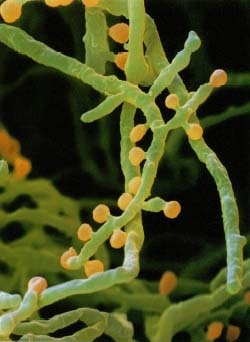Fungal Infections

Fungi are organisms that can grow in or on the body, causing infections of internal organs or of the skin, nails, and hair.
KEYWORD
for searching the Internet or other reference sources
Mycology
Bread mold and mushrooms are among the most familiar examples of fungi (FUN-ji), organisms that grow in an irregular mass without roots, stems, or leaves. Fungi feed on other organisms, living or dead, and play an important role in helping dead plants and animals decay. Of the thousands of species of fungi, a few can cause human disease.
These fungi cause a wide range of illnesses, from minor skin conditions to life-threatening diseases. They produce two kinds of infections: systemic and superficial. Systemic infections affect internal organs. They often start in the lungs, but in severe cases may spread to the blood, heart, brain, kidneys, liver, or other parts of the body. Superficial infections affect the surface of the body, the skin, the nails, and the hair. They most often occur in moist areas, such as between the toes, in the crotch, or in the mouth.
What Are Superficial Fungal Infections?
Superficial fungal infections attack tissues on the surface of the body, which include the skin, nails, or hair. Some common examples are ringworm, athlete's foot, jock itch, and yeast infections. Candida yeast * infections are usually found on the skin, in the mouth, in the vagina, on the head of the penis, or around the nails. Superficial fungal infections are somewhat contagious and pass from person to person through direct contact or, less commonly, through clothes or contact with surfaces of other objects in the environment.
What Are the Signs and Symptoms of Superficial Fungal Infections?
Although the symptoms produced by infection with different types of fungi varies, these infections generally cause itching, reddened skin, and inflammation. Some superficial skin infections are mild and produce few or no symptoms. Others are more irritating. Superficial fungal infections are rarely life threatening, but they may cause considerable discomfort or embarrassment.
* yeoast (YEEST) is a type of fungus.
How Do Doctors Diagnose and Treat Superficial Fungal Infections?
Skin infections
Superficial fungal infections are often diagnosed on the basis of their appearance and their location on the body. Most skin infections respond well to topical antifungal creams, some of which are available over the counter, which means they do not require a doctor's prescription. Other skin infections, however, do not respond to such treatment. They require a doctor's attention and systemic treatment with prescription antifungal medications.
Candidiasis
Candida yeast infections are diagnosed by staining specimens of sputum or urine, or scrapings from the skin or the lining of the mouth or vagina, and by examining them under a microscope. People with vaginal yeast infections can be effectively treated with medications. Occasionally, repeated courses of treatment may be required.
How Do People Prevent Superficial Fungal Infections?
Preventing superficial fungal infections is difficult because people are continually exposed to fungi. Keeping the skin dry and clean is probably helpful.
What Are Systemic Fungal Infections?
Some fungi are normally present in the body, kept under control by the body's immune system. If the immune system is abnormally weak, however, the fungi can grow out of control and cause illnesses. These are termed opportunistic infections. Among the most common opportunistic fungal infections that affect people are:
- candidiasis
- aspergillosis
- phycomycosis
- cryptococcosis

People with AIDS (acquired immune deficiency syndrome), people with leukemia (cancer of the blood cells), and people with Hodgkin's disease or other kinds of lymphoma (cancer of the immune system) are at risk for opportunistic fungal infections because their immune systems have been weakened. Such infections may also occur in people who are receiving radiation therapy or chemotherapy, or who are taking corticosteroids * or immunosupressant * drugs, such as the drugs a person takes after an organ transplant.
* corticosteroid (kor-ti-ko-STEER-oids) are medications that are prescribed to reduce inflammation and sometimes to suppress the body's immune responses.
* immunosuppressants (im-yoo-no-su-PRES-ants) are substances that weaken the body's immune system.
People who have received prolonged courses of antibiotics for treatment of serious bacterial infections are also at risk for fungal infections.
Other fungi cause illnesses even in otherwise healthy people with normal immune systems. In these cases, people inhale the spores (immature form) of fungi that normally live in the environment, especially the soil, in certain geographical areas. Examples include:
- Histoplasmosis (his-to-plaz-MO-sis) occurs in the United States in the east and midwest, in Mexico, and in Central America. The fungus that causes it often grows on chicken droppings and bat guano.
- Coccidioidomycosis (kok-sid-e-oi-do-my-KO-sis), or Valley fever, is found in the southwestern United States.
- North American blastomycosis (blas-to-my-KO-sis) is found throughout North America, and outbreaks recently have been reported in Africa as well.
- South American blastomycosis, which is caused by a different fungus, is seen in South and Central America.
What Are the Symptoms of Systemic Fungal Infections?
Systemic fungal infections often are chronic * and develop slowly, taking weeks or months to become a problem. Symptoms are sometimes similar to those of the common cold, but sometimes, especially in people with weakened immune systems, symptoms may be sudden and severe, requiring hospitalization. Symptoms may include cough, fever, chills, night sweats, anorexia (loss of appetite), weight loss, general fatigue, and depression.
If the infection spreads from the lungs to other organs, it may be particularly severe, especially if the patient has a weakened immune system. For example, cryptococcosis (krip-to-ko-KO-sis) may lead to meningitis (men-in-JY-tis), which causes inflammation and swelling of the lining around the brain and spinal cord.
How Do Doctors Diagnose and Treat Systemic Fungal Infections?
Diagnosis
Diagnosing and treating systemic fungal infections can be a challenge for a doctor. Many of the symptoms are mild and vary greatly from person to person. Blood or skin tests exist for only a few of these infections and often are inconclusive or fail to find a fungus that really is there, a result called a false negative. Chest x-rays may show abnormalities in the lungs as fuzzy white spots on the black x-ray film, but the spots do not identify the specific cause.
A diagnosis of systemic fungal infection usually is confirmed when a fungus is cultured, or grown, in a laboratory dish from a sample of the patient's sputum, bone marrow, urine, blood, cerebrospinal (ser-e-bro-SPY-nel) fluid, or other tissue.
* chronic (KRON-ik) means continuing for a long period of time.
Treatment
Treatment varies, depending on which fungus is causing the condition and how severe the symptoms are. Doctors usually prescribe antifungal medications, with drug therapy sometimes continuing for several weeks. In some cases, particularly if the immune system is weak, drug treatment may fail, or the doctor may recommend surgery to remove infected tissues.
Resources
The U.S. National Institutes of Health has a search engine at its
website that locates information about fungal infections and mycology,
which is the scientific study of fungi.
http://www.nih.gov
The U.S. National Eye Institute posts a fact sheet at its website about
how the fungal infection histoplasmosis affects vision.
http://www.nei.nih.gov/TextSite/publications/histo.htm
Comment about this article, ask questions, or add new information about this topic: